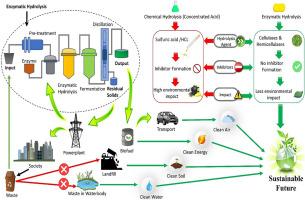Graphing the Green route: Enzymatic hydrolysis in sustainable decomposition
IF 4.8
Q1 MICROBIOLOGY
引用次数: 0
Abstract
This graphical review article explores how sustainable decomposition contributes to environmental sustainability in waste management with a focus on enzymatic hydrolysis. Methods such as composting and anaerobic digestion efficiently break down organic waste and reduce landfill use and greenhouse gas emissions, while producing valuable resources such as compost and biogas. In particular, enzymatic hydrolysis offers advantages over chemical methods because it operates under mild conditions, targets specific substrates precisely, and yields purer products with fewer side reactions. Its renewable and biodegradable nature aligns with sustainability goals, making it suitable for waste decomposition, biorefining, and resource recovery. Enzymatic waste conversion reduces waste and pollution, conserves natural resources, and supports circular economy. Various ongoing studies have aimed to enhance the efficiency and environmental benefits of enzymatic hydrolysis, enabling innovative waste-to-value solutions that address environmental, economic, and social challenges. This article emphasizes the importance of its timely examination of enzymatic hydrolysis as a prominent method for sustainable waste decomposition, stressing its environmental, economic, and societal benefits. It distinguishes itself through its extensive analysis of chemical methods, its emphasis on the circular economy, and its delineation of future research directions and the need for interdisciplinary collaboration to advance this innovative technology.

图解绿色路线:可持续分解中的酶水解作用
这篇图解评论文章以酶水解为重点,探讨了可持续分解如何在废物管理中促进环境的可持续发展。堆肥和厌氧消化等方法可有效分解有机废物,减少垃圾填埋场的使用和温室气体的排放,同时产生堆肥和沼气等宝贵资源。与化学方法相比,酶水解法尤其具有优势,因为它的操作条件温和,能精确地针对特定的底物,产生的产品更纯净,副反应更少。其可再生和可生物降解的特性符合可持续发展的目标,使其适用于废物分解、生物精炼和资源回收。酶促废物转化可减少废物和污染,保护自然资源,支持循环经济。目前正在进行的各种研究旨在提高酶水解的效率和环境效益,从而实现从废物到价值的创新解决方案,应对环境、经济和社会挑战。这篇文章强调了及时研究酶水解作为可持续废物分解的重要方法的重要性,强调了其环境、经济和社会效益。文章通过对化学方法的广泛分析、对循环经济的强调、对未来研究方向的界定以及为推进这一创新技术而进行跨学科合作的必要性,使自己脱颖而出。
本文章由计算机程序翻译,如有差异,请以英文原文为准。
求助全文
约1分钟内获得全文
求助全文
来源期刊

Current Research in Microbial Sciences
Immunology and Microbiology-Immunology and Microbiology (miscellaneous)
CiteScore
7.90
自引率
0.00%
发文量
81
审稿时长
66 days
 求助内容:
求助内容: 应助结果提醒方式:
应助结果提醒方式:


